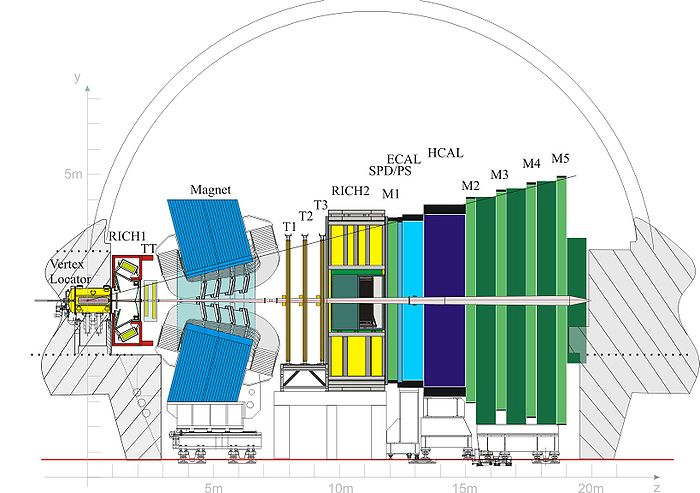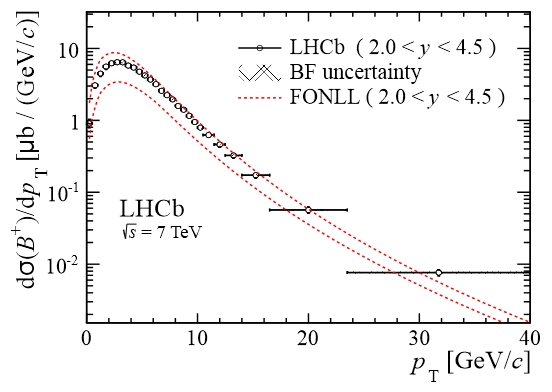A sketch of the LHCb layout is shown below.

(In the picture you can see the various detector elements seen from a side. The interaction point is on the left.)
You might well ask, Why does a similar arrangement targets B production ? The answer is simply that B hadrons are copiously produced in those very asymmetric collisions; the added bonus is that they exit the collision point with high momentum -driven by that of the higher-momentum parton- and so they travel long distances before decaying: this makes their identification and study much easier.
The lifetime of most B hadrons is only slightly higher than one picosecond or so (10 to the minus 12 seconds), so a B hadron moving slowly will decay where it is created or at an immeasurably close distance from there. But there comes the relativistic dilatation of times: if a particle moves with respect to us at a speed close to the speed of light, time for it will move slower than it does for us!
So if the B hadron has, say, a momentum of 500 GeV, it will live a lifetime a hundred times as long as its 1.5 x 10^-12 seconds, as viewed from the laboratory frame; this will allow it to travel several centimeters away from the production point, making it very easy to reconstruct its characteristics.
It is fun to note that while B hadrons were considered heavy objects in the past century (charmed and bottom hadrons are in fact still called "heavy flavoured hadrons"), it is their being light -light as compared to the collision energy!- that makes them being mostly produced in very forward-going collisions of LHC protons. In order to explain the relationship between center of mass energy, rapidity, and parton momenta I would however deviate considerably from my original goal in this article, so I hope readers will take my word for it...
Now, LHCb produced a new paper in the arxiv today, which reports on an important measurement of the production rate of B mesons - particles composed of a b quark together with a lighter quark. The measurement is very important for particle physicists, because it allows us -er, them- to verify their understanding of low-energy quantum chromodynamics interactions that take place when the B meson is created.
B meson candidates (B^+, B^0, and B_s mesons are separately studied: these are the combination of a anti-b quark with a up, a down, and a strange quark, respectively) are collected by relying in the identification of a J/ψ meson, which is a frequent and clean decay product of the B particles: the J/ψ decays to a pair of muons, which can be measured and identified very precisely thanks to their characteristic penetration power.
Once a J/ψ is reconstructed, the combination with a positive kaon, or a neutral one, or a phi particle yield clean signals of the three B meson species. A fit of the mass spectrum of the candidates allows their count, and given the large statistics of the collected dataset, it is possible to study the production rate as a function of the kinematic characteristics of the B meson candidates: their momentum transverse to the beam direction, and their rapidity (a variable connected with their angle of production).

Above is one of the figures from the LHCb paper. It shows that the physical quantity determining the production rate of these particles, the "cross section" (in this case the one measured for the B^+) is determined very precisely as a function of transverse momentum. A comparison with existing theoretical models allows to further our understanding of the mysterious production mechanisms of hadronic collisions.





Comments